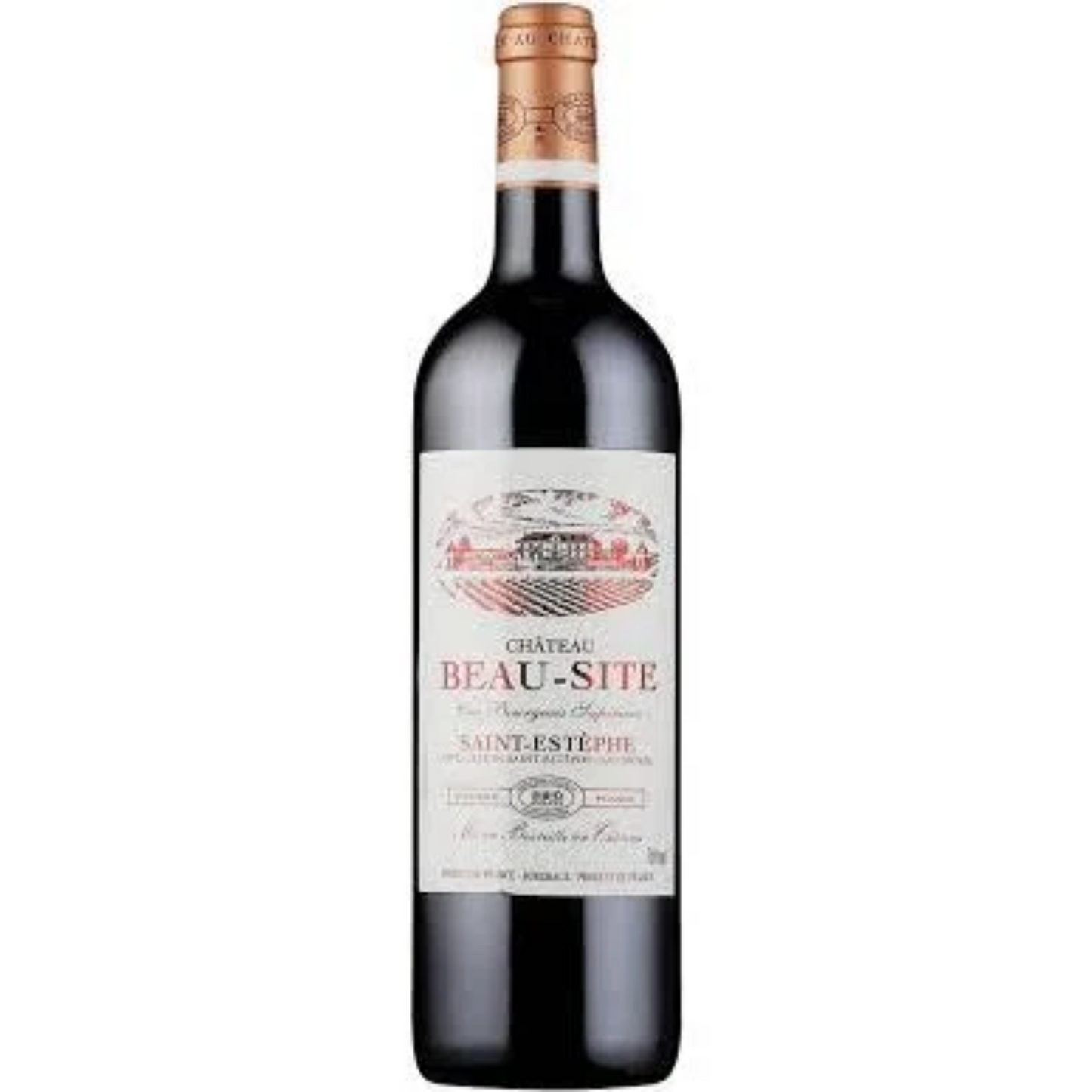Château Beau-Site Saint-Estèphe 2018
Château Beau-Site Saint-Estèphe 2018
Vintage: 2018
Volume: 750ml
Country: France
Region: Bordeaux
Grapes: 73% Cabernet Sauvignon, 25% Merlot, and 2% Petit Verdot.
ABV: 14.5%
Scores:
Product Code: FRCBESI2018ST001
Couldn't load pickup availability
Winery Background and History
Château Beau-Site, translating to “beautiful site,” is a historic estate located in the Saint-Estèphe appellation of Bordeaux, France. Established in the 18th century, it is situated near the renowned Château Calon-Ségur, highlighting its esteemed terroir. In 1955, the estate was acquired by the Castéja family, who have since invested in modernizing the vineyard and winemaking facilities. Notably, Château Beau-Site boasts one of the oldest underground cellars in the Médoc, dating back to the 18th century, providing optimal conditions for aging wines. Today, the estate seamlessly blends traditional winemaking techniques with contemporary practices, producing high-quality wines that reflect both heritage and innovation.
Producer and Winemaker
Under the ownership of the Castéja family, Château Beau-Site benefits from the expertise of a dedicated winemaking team committed to expressing the unique terroir of Saint-Estèphe. The estate’s operations are overseen by experienced professionals who emphasize meticulous vineyard management and precise vinification processes. Their approach combines respect for traditional methods with the integration of modern oenological advancements, aiming to produce wines that are both reflective of their origin and appealing to contemporary palates. This commitment to quality and authenticity has solidified Château Beau-Site’s reputation in the competitive landscape of Bordeaux wines.
Vineyards and Micro Climate
Château Beau-Site’s vineyards encompass approximately 40 hectares, with vines averaging 35 years of age. The estate is located near the village of Saint-Corbian, at the northern extremity of the Saint-Estèphe appellation. The vineyards are characterized by their stony, gravelly soils, which provide excellent drainage and contribute to the development of deep root systems. This soil composition, combined with the vineyard’s elevation, fosters a microclimate conducive to the cultivation of late-ripening grape varieties, particularly Cabernet Sauvignon. The proximity to the Gironde River further moderates temperatures, reducing the risk of frost and promoting a long, even growing season. This unique combination of soil and climate conditions enables Château Beau-Site to produce wines with notable structure, complexity, and aging potential, hallmarks of the Saint-Estèphe appellation.
Grape Varietals & Percentage Used
The 2018 vintage of Château Beau-Site is composed of 73% Cabernet Sauvignon, 25% Merlot, and 2% Petit Verdot.
Vinification & Aging Methods
The winemaking process at Château Beau-Site adheres to traditional Bordeaux practices, enhanced by modern techniques to ensure precision and quality. Harvesting is conducted manually, allowing for careful selection of grapes at optimal ripeness. Upon arrival at the winery, the grapes undergo destemming and are gently pressed before fermentation. Fermentation occurs over four weeks in temperature-controlled stainless steel vats, with each plot vinified separately to preserve the distinct characteristics of the terroir. Malolactic fermentation takes place in stainless steel tanks. The wine is then aged in French oak barrels, with approximately 40% being new oak, for a period of 16 months. This regimen imparts subtle oak nuances and contributes to the wine’s structural complexity. Throughout the aging process, the wine is regularly monitored and racked as necessary to ensure clarity and stability. Prior to bottling, the wine may undergo fining and light filtration to achieve desired clarity and purity. This meticulous approach to vinification and aging results in a wine that embodies the robust character and elegance associated with the Saint-Estèphe terroir.
ABV (Alcohol by Volume)
The 2018 Château Beau-Site Saint-Estèphe has an alcohol content of 14.5%.
Tasting Notes
The 2018 vintage of Château Beau-Site presents a rich, ripe, and brooding nose with medium-high to high intensity aromatics of dark red and black fruits, currant, cassis, and black cherry notes, complemented by spicy, fine wood spices, and sandalwood surrounding a core of savory forest floor. On the dry, full-bodied palate, it is rich, spicy, and a touch warm with savory earth, fine wood spice, blackcurrant, blackberry, black cherry, and graphite mineral flavors accented with dried herbs. Some licorice and clove spice notes appear on the mid-palate to add further interest. Acids are juicy and mouth-watering, while the refined, well-structured tannins have a gently chalky textured mouthfeel and are quite approachable at this stage. Savoury, graphite, and dried herb notes linger on the exceptionally long finish. This wine is expected to improve further with age and can be enjoyed into the mid-2030s.
Food & Wine Pairing
This wine pairs exceptionally well with rich meats such as beef, lamb, and game. The robust flavors and structured tannins complement hearty fare, enhancing the overall dining experience. Additionally, the wine’s earthy and savory notes make it a suitable companion for dishes featuring mushrooms or truffles, as well as aged cheeses that can match its depth and complexity.
Service Methods and Temperatures
To fully appreciate the nuances of the 2018 Château Beau-Site Saint-Estèphe, it is recommended to serve the wine at a temperature between 16°C and 18°C (60°F to 64°F). Decanting the wine for approximately one hour prior to serving can help in aerating and revealing its complex aromas and flavors. Utilizing Bordeaux-style wine glasses will further enhance the tasting experience by allowing the wine to breathe and concentrate its bouquet.
Storage and Aging Potential
Stored under optimal conditions—consistent temperature around 12°C (54°F), with appropriate humidity and away from direct light—the 2018 Château Beau-Site Saint-Estèphe has the potential to age gracefully for 8 to 12 years from its vintage date. As it matures, the wine is expected to develop deeper complexity, with the integration of its fruit, tannins, and subtle earthy
Share


